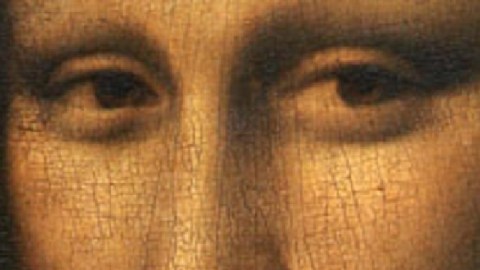Seek and Find: Discovering a Da Vinci Code in the Mona Lisa

It’s amazing what you can find in art when you really, really want to find it there. Italy’s National Committee for Cultural Heritage claims that they’ve found evidence of a real-life “Da Vinci Code” hidden in the pupils of the eyes of the Mona Lisa. Tiny letters and numbers too small to be seen by the naked eye “can clearly be seen” under a magnifying glass, claims Silvano Vinceti, the organization’s president. Did Leonardo Da Vinci really hide miniscule clues to some great mystery in the eyes of La Gioconda? If so, what can that mystery be? If not, is this just a case of wishful thinking—“seek and you shall find” on a grand scale? Color me incredulous, but I think this announcement is more about Italy’s pursuit of the Holy Grail of tourist dollars than anything else.
Vinceti’s group claims to see the letters “LV” in the right pupil clearly, suggesting perhaps Leonardo signing the work with his initials. The left pupil gives up its secrets less easily, with the markings possibly being either the letters “CE” or the letter “B.” They even claim to see the number “72” or and “L” and “2” hidden in the arch of the bridge behind the smiling woman. “You have to remember the picture is almost 500 years old so it is not as sharp and clear as when first painted,” Vinceti says in defense of his group’s difficulty in making out the code they claim to have found. “From the preliminary investigations we have carried out we are confident they are not a mistake and were put there by the artist.” This confidence in their findings borders on the breathtaking. Perhaps even more breathtaking is the group’s desire to have Leonardo’s remains exhumed so that forensic science can use his skull to recreate what he would have looked like to settle once and for all the question of whether the Mona Lisa is actually a secretive self-portrait. These code breakers never quit!
I find it very hard to believe that such letters and numbers could have gone undetected until now on one of the most intimately studied paintings ever. Earlier this year, a French team published their findings using noninvasive x-ray fluorescence to study Leonardo’s sfumato technique in the Mona Lisa. They found that the artist applied the glazes in layers as thin as 1 to 2 micrometers, with the total thickness coming to no more than 30 to 40 micrometers—approximately half the thickness of a human hair. And yet no letters or numbers turned up in their study. Wait, you might counter-argue, they were looking at the paint and not what was painted. Maybe they missed the code by looking too small, you say. OK, fair enough. Let me introduce you to photographic engineer and inventor Pascal Cotte, subject of the film Mona Lisa Revealed: Secrets of the Painting (which I reviewed here). In October 2004, when the Louvre moved the Mona Lisa from its previous position to its present spot, the French National Museum Laboratory asked Cotte to use his special photographic equipment to document the masterpiece as never before. Using a “multi-spectral” process of thirteen different scans of the painting, Cotte created images at 240 million pixels resolution—eight times greater than any photograph ever made before of the painting. If a magnifying glass could find these symbols, then Cotte’s cameras should have made them larger than life. Alas, of the many secrets Cotte’s techniques forced Mona to give up, including the existence of long-lost eyebrows, a code hidden in her pupils was not one of them.
So, why has Italy’s National Committee for Cultural Heritage made this claim? I don’t doubt that they see what they claim to see. However, if you look long enough at any brushstroke under a magnifying glass, you’ll eventually see something recognizable—maybe even the artist’s initials. Although the painting lives today in France, the history of Leonardo will always remain in Italy. Tourists still flock to Italy to take tours tracing the stories of Dan Brown’s page turners. What better way to stoke the fires of art and mystery lovers’ interest in a chilly economic climate globally than to discover a “real-life” code? Again, I’m not accusing them of outright deception—just some overly optimistic viewing. In the end, it’s all harmless fun that puts great art on the front page and in the front of peoples’ minds for a day. The only real harm is when people take such fictional code claims more seriously than the reality of the beauty of the work and the mastery of the artist, who remains more than just a dropper of obscure clues, if he ever dropped them at all.





